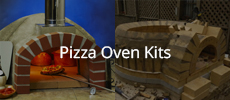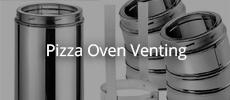Announcement
Collapse
No announcement yet.
2024 Neapolitan oven build
Collapse
X
-
As long as you feel comfortable that there is an egress point for water vapor to escape you should be good. Liquid water when it sublimates to gas increases volume by about 1500 times hence a need to have some type of mechanism to reduce pressure building up under the finish coat of the oven.
-
Pressure/ Steam release valve unplanned alternative should work.
Times coming where I really need to have a solution sorted, and I have a couple of possibilities. 1. a Hydraulic release valve, and 2. Aeration cap. But…. I‘m wondering if I will actually need one, as I possibly can vent any steam or pressure build up through the chimney.
Let me explain.
To avoid adding extra thermal mass, the sides and front of the chimney are entirely bering built arch which is forward of the heat break. The goal is to reduce any heat loss via conduction. I have a Lintel that will run from side to side of the oven over the top of the dome and the rear wall of the chimney will be built on it. 100mm of Ceramic fibre blanket will go over the dome, and under the rear wall of the chimney. The vent with the Schamott flue that sit on the arch will be insulated in the space between them and the outer chimney wall.
Hope that paints a clear picture. Point is, any pressure or steam that is captured between the dome and the outer render will automatically release up the chimney and out the top. Is there any reason this would not work?
I read that david s has incorporated a custom vent release that uses the chimney, albeit he has planned for that. Mine was not planned, but I am wondering if it is worth adding a release valve in the top of the dome now?
Leave a comment:
-
Brickwork of Chimney and front of oven.
I started work on the brickwork of the chimney, and the front of the oven this week. I‘m doing it in stages, using left oven cement paver/ wall bricks for the sides. I used the last of my schamott bricks to build up over the arch today. I don‘t want to build the rear wall on the back of the chimney directly on the dome, so I have 2 options to use either a steel lintel, or reinforced concrete lintel supported by the sides and crossing over the dome. I will leave space under it to properly insulate the dome. I‘m specifically trying to avoid loss of heat through conduction from the main thermal mass to the brickwork around the chimney. I‘ll be posting more photo‘s as I progress. The brickwork will be rendered, leaving only the main arch visible around the opening as a feature on the front of the oven.
Leave a comment:
-
Nobody is going to look inside the top of the oven when it is 700F, they will be amazed how quickly and tasty the pizzas that come out are. Plus the dome is going to soot up every time you fire until it clears off (about 700F plus and there is also a unique smell when the carbon starts to burn off, kind of like an ozone smell).
Leave a comment:
-
I was pretty disciplined when doing the dome, after each row I washed down and cleaned the bricks because I found out early the cement set like stone. What I have is some dirty water stains. I tested today with 50/50 vinegar water mix and it does the job, makes it easy to remove it with a wet rag. But to be honest, the inside of the dome is clean enough for me. The photos I posted the last days were deceiving, because the dark part inside the dome is where it was wet from me cleaning it. Today it had dried out more and the dark patch is not there.Originally posted by rsandler View PostI found vinegar and a wire brush moderately helpful for small amounts of relatively fresh mortar and very helpful for efflorescence. Mind you, I was using the homebrew Portland cement-based mortar, not the calcium aluminate-based stuff you have, so your mileage may vary there.
As if its not already cramped fitting through the arch into the low dome, I sprayed some vinegar in there today and if I was going to do it I would need to wear a mask. I‘m not doing that.
Leave a comment:
-
I found vinegar and a wire brush moderately helpful for small amounts of relatively fresh mortar and very helpful for efflorescence. Mind you, I was using the homebrew Portland cement-based mortar, not the calcium aluminate-based stuff you have, so your mileage may vary there.
- Likes 1
Leave a comment:
-
Vinegar and water mix is pretty benign and works best on efflorescence vs mortar. IMHO, give it a try, nothing to lose. I used muratic acid and water on the exterior of my oven to remove the efflorescence but it is definitely more aggressive and PPE is need.
- Likes 1
Leave a comment:
-
Removed Indispensable Tool; refitted the center floor brick; fitted Schamott flue to vent.
It’s Sunday, there is a law in Germany against working on Sunday apparently, or so my wife always tells me. She was away this weekend so I forgot about that and reverted to my Australian conditioning.
I cleaned out the floor of the oven with a vaccum. Lots of dregs around the IT well in the middle of the floor which I didn‘t want to fall into the brick space when I removed it. Had my fingers crossed that the minimal sand I put in there when I levelled the floor was still in place, and if I could avoid stuff falling in when removing the IT, then the block should theoretically slip back in to place nice and level. The theory was good. The block dropped in with a flew little taps of the rubber hammer. Perfect level.
I chipped a little of the surplus cement spots away from the inside of the dome. Still needs a good clean, as my dirty rag left dirty water marks. I read someone used a vinegar and water mix to clean their oven. Does that really work? I have seen it used on external walls. Don‘t want to do any damage to the cement on the dome though.
I cemented the Schamott flue pipes on the vent, that was easy. Then I enjoyed the rest of the day off, apart from doing some calculations in sketchup on the chimney brickwork I want to start this week.
Leave a comment:
-
Keystone in and dome done; Vent fitted
Keystone in.
After letting the keystone set for a few hours, I crawled down the plank on my back into the oven dome. Really not fun! Our son and a friend of his helped by inserting the keystone and fitting it. I got shoulder cramp half way through, unable to easily get out, and without space to stretch, it was really a test of my endurance of pain. I breathed through and got the keystone in, although 1mm lower on one side, acceptable for me. I left the handle on top of the keystone, not that I will use it now, but it was handy to hold on to, to fit it. I might just see if I can’t repurpose it into a decorative flower, that no one will ever see when it buried under the insulation.
I left the handle on top of the keystone, not that I will use it now, but it was handy to hold on to, to fit it. I might just see if I can’t repurpose it into a decorative flower, that no one will ever see when it buried under the insulation.  But I will know it is there. I have a little bit of cement stuck in the inside of the roof, which is annoying me, So I might venture in once more with a chisel to chip it out, so it looks nice.
But I will know it is there. I have a little bit of cement stuck in the inside of the roof, which is annoying me, So I might venture in once more with a chisel to chip it out, so it looks nice.
Fitted the vent cast.
I’m so happy the dome is finally done. I moved to thinking about starting the chimney, and asked my son’s friend for help to fit the vent cast I made. I would like to give credit to david s . It was his generous sharing of knowledge and experience, and support that inspired me to cast the vent in refractory concrete. The arch vent is rectangular, and transitions through the refractory concrete vent to 200mm diameter circular vent at the top on which I have mounted a schamotte adapter plate for 2 x 200mm schamott flue pipes. The transition from the rectangular vent in the arch to the circular vent to accomodate the 200mm flue is the same area so it doesn’t impede the smoke flow up the flue. Also curved walls in the refractory concrete vent so to allow smooth flow upwards.
It sounds a lot, but with Davids input I made it happen as the last think I want is smoke flowing out the front of the arch. I was admiring it once it was fitted. Thank you David. I’m so glad you gave me the tip and support by patiently answering my many questions.
Leave a comment:
-
Custom Keystone Sun
My ring of wedges set nicely overnight, so after watching the AFL (Australian Football League) grand final, I made the most of no rain and cut the bricks I cemented together to get myself a piece of brick to make the keystone insert for the wedge ring.
I marked the top and bottom of the cemented brick from the templates I made overnight to match the top and bottom of the hole.
Another perfect use for mr Chipsters jig. Set the angle for the side cuts, then in 5 minutes the piece was ready. I made a few small adjustments with the 125mm grinder, and it fitted really well.
I took the wedge ring to test the fit in the top of the oven dome, and it needed some brick removed from the outside. I used the wet cutting saw to make cut the majority, then used the grinder to take out the rest. The ring held together.
I cemented the keystone into the wedge ring, leaving a small handle on top to make it easier to drop into the oven dome hole. It turned out like a sun, with the wedge pieces around the circle, I’m sufficiently happy with it that I decided not to cut the keystone from my above listed option 2. Will fit it in a few hours, weather permitting.
I know many build the Tuscan style dome. My recommendation, if you have any claustrophobic tendencies, then it would be preferable over the Neapolitan style dome. I set up a plank from the front of my ladder to the oven opening, laid on my back, then crept backwards with one arm over my head so i could fit in. I’m not claustrophobic and it had me on edge. I wanted to check the inside of the dome, and fill any small gaps with cement while there is still light from the small hole in the top of the dome. I got used to it after bing in there a little while, but it’s definitely not fun.
Some pics of the evolution of the custom keystone.
- Likes 1
Leave a comment:
-
“I wonder if it’s possible to trigger the binding process at temps less than 800C?”
Sintering begins at 573C when the body becomes permanent due to temperature. As the temperature gets higher the body becomes harder and stronger. Stoneware (1200-1300 C) much harder than earthenware (600-1200 C), porcelain (1300C+) harder than stoneware. Unfortunately the 500-650C range can be quite damaging because different materials have different expansion rates which leads to damage unless ramped up slowly and controlled. This is something not possible with a wood fired oven because of the chamber design and the fuel used, so it’s highly likely to result in damage if attempted. The castable refractory proves quite adequate for WFO service temperatures.
Additionally if sand is used as the mortar’s aggregate rather than crushed fired clay (grog), it has a tendency to turn to glass at higher temperatures, particularly in the presence of fluxes.Last edited by david s; 09-28-2024, 07:34 AM.
Leave a comment:
-
Yes, silicon oxide based. SiO2Originally posted by david s View PostCastable refractory uses calcium aluminate cement as the active cementious ingredien. Its fast setting and curing and refractory nature make it a suitable material. Using a conservative firing schedule up to service temperature, with the addition of burnout fibres, prevents steam spalling. The material only begin to vitrify above 600C, converting the chemical bond of the cementious proportion to a truly sintered body. This same material is used fore commercially cast ovens.
The other product you are referring to I think is a sodium silicate based one. Check the data sheet on the product for details.
I wonder if it’s possible to trigger the binding process at temps less than 800C? In the information it states “around 800C”.
Thanks for the info David. When my ovens finished I’ll do and experiment and bake a few bricks at around 600C to see how the binding is after.
Leave a comment:
-
Castable refractory uses calcium aluminate cement as the active cementious ingredien. Its fast setting and curing and refractory nature make it a suitable material. Using a conservative firing schedule up to service temperature, with the addition of burnout fibres, prevents steam spalling. The material only begin to vitrify above 600C, converting the chemical bond of the cementious proportion to a truly sintered body. This same material is used fore commercially cast ovens.
The other product you are referring to I think is a sodium silicate based one. Check the data sheet on the product for details.
Leave a comment:
-
That’s interesting. I understand why, as it’s fiddly as when the hole gets smaller. I thought as I got to the last courses it would get easier, but it’s the opposite. Requires more care and attention to detail.Originally posted by david s View PostBen Guillford’s Melbourne Firebrick Company that sells a brick kit just replaces the last 3 or so rows with castable refractory and it is fired in place.
Does the castable refractory require firing to set?
It raises a question I have about two different types of fire cement/ mortar available here in Germany.
1. Hydraulic binding mortar. Binding/ setting process is chemically triggered with addition of water. Has 30% clay,
2. Ceramic binding mortar. Binding is made through firing at temperatures of around 800C.
I’ve used hydraulic binding cement, and gotten used to it. The bricks need to be wet, and once cement added I need to put it exactly in place within seconds of contact as the water is sucked out as soon as two bricks are in contact.
Ceramic binding mortar was sent by mistake in my last order and I laid a course using it. It was totally different in consistency, a dream to work with. Stays creamy even after bricks are together, and allows for easy adjustments once they are. Can add brick wedges in gaps very easily. I removed the course and mortar as I wanted to complete the oven using the hydraulic setting mortar. I was unsure how, and if the ceramic binding mortar would set with temperatures reached in the oven.
Do you know if it’s possible to use ceramic setting mortar on an oven dome? It would make life much easier fitting the bricks.Last edited by daidensacha; 09-27-2024, 09:15 PM. Reason: Edited and changed wording of names of the types of mortar
Leave a comment:
-
I have two separate options both in process and I’ll choose the one I prefer when it’s clear to me.
I managed to cement the wedges from option 1 above together and it’s drying inside overnight. I’ll cut down and cement a keystone in it. I figure in one piece it will be stronger. I’ll leave enough keystone sticking out the top to use as a handle so I can hold to drop it into the hole when fitting. Can cut that off after cementing it in. It’s very close to the hole size but will need some minor fitting adjustments.
I’ll also start cutting down my option two using the wet cutting saw to get my side cuts of the stone. Hopefully that will mean less grinding and the bricks will hold together.
Last edited by daidensacha; 09-27-2024, 06:34 PM.
Leave a comment:





Leave a comment: